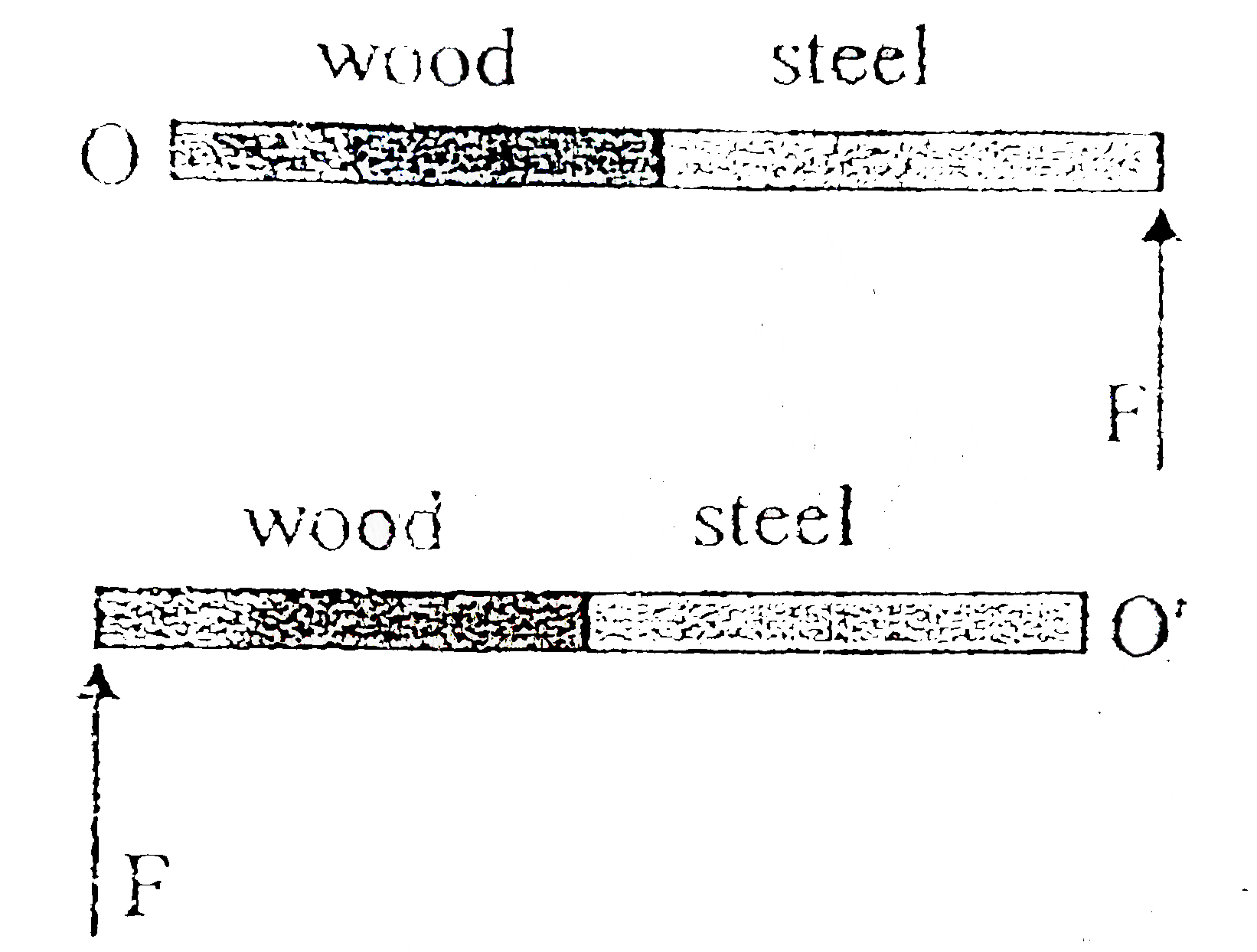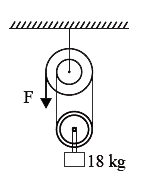In first figure a meter stick, half of which is wood and the other half steel is pivoted at the wooden end at A and a force is applied at the steel and at O. On second figure the stick is pivoted at the steel end at O and the same force is applied at the wooden end at A. The angular acceleration.
 .
.
in first is greater than in second
equal in both first and second
in second is greater than in first
None of the above.
The correct Answer is:C
( c) Torque will be same in both cases, but moment of inertia is less in second case, hence angular acceleration is greater in this case.
Topper's Solved these Questions
- ROTATIONAL DYNAMICSBook:A2ZChapter:ROTATIONAL DYNAMICSExercise:Angular Momentum And Its Conservation
Explore 30 Videos
- ROTATIONAL DYNAMICSBook:A2ZChapter:ROTATIONAL DYNAMICSExercise:Work And Energy In Case Of Rotation
Explore 22 Videos
- ROTATIONAL DYNAMICSBook:A2ZChapter:ROTATIONAL DYNAMICSExercise:Rotational Kinematics
Explore 19 Videos
- PROPERTIES OF MATTERBook:A2ZChapter:PROPERTIES OF MATTERExercise:Chapter Test
Explore 29 Videos
- THERMAL PROPERTIES OF MATTERBook:A2ZChapter:THERMAL PROPERTIES OF MATTERExercise:Chapter Test
Explore 30 Videos
Similar Questions
A meter stick, half of which is wood and the other half steel, is pivoted at the wooden end and same force isapplied to the steel end. Next, it is pivoted at the steel end and the same force is applied at the wooden end. Does one getthesame angular acceleration in eachcase ? Explain
View SolutionIn first figure a meter stick, half of which is wood and the other half steel is pivoted at the wooden end at A and a force is applied at the steel and at O. On second figure the stick is pivoted at the steel end at O and the same force is applied at the wooden end at A. The angular acceleration.
 .
.
View Solution
Knowledge Check
Figures 1 and 2 below show a meter stick, haif of which is wood and half of which is steel. (Steel is denser than wood). In figure 1, the stick is pivoted at the wooden end, at O, and a force F is applied to the steel end. In figure 2, the stick is pivoted at the steel end at O, and an identical force is applied to the wooden end. [Neglect Gravity].
 AThe angular acceleration will be greater for the stick in figure. 1. because the torque about Q is greater than the torque about O'BThe angular acceleration will be greater for the stick in figure 2, because the torque about O' is greater than the torque about O.CThe angular acceleration will be greater for the stick in figure 1 because the rotational inertia about O is smaller than the rotational inertia about O'DThe angular acceleration will be greater for the stick in figure 2 because the rotaional ineria about O' is smaller man the rotational ineria about O.
AThe angular acceleration will be greater for the stick in figure. 1. because the torque about Q is greater than the torque about O'BThe angular acceleration will be greater for the stick in figure 2, because the torque about O' is greater than the torque about O.CThe angular acceleration will be greater for the stick in figure 1 because the rotational inertia about O is smaller than the rotational inertia about O'DThe angular acceleration will be greater for the stick in figure 2 because the rotaional ineria about O' is smaller man the rotational ineria about O.In the figure (i) half of the meter scale is made of wood while the other half, of steel. The wooden part is pivoted at O. A force F is applied at the end of steel part. In figure (ii) the steel part is pivoted at O and the same force is applied at the wooden end
 AMore acceleration will be produced in (i)Bmore acceleration will be produced in (ii)Csame acceleration will be produced in both conditionsDinformation is incomplete
AMore acceleration will be produced in (i)Bmore acceleration will be produced in (ii)Csame acceleration will be produced in both conditionsDinformation is incompleteThe adjacent figure shows a non-uniform metre stick AB having the linear mass density variation λ=λ0x , where λ0 is a constant and x is the distance from end A, placed on a smooth horizontal surface. In the first experiment, the rod is pivoted at A and force F is applied perpendicular to the rod at the other end B and in the second experiment, the rod is pivoted at B and the force is applied perpendicular to the rod at the end A. If in the first case angular acceleration is αA and in the second case it is αB then
 AαA=αBBαA>αBCαA<αBDdata insufficient to determine
AαA=αBBαA>αBCαA<αBDdata insufficient to determine
AB is a stick half of which is wood and the other half steel. IA is moment of inertia about an axis passing through A and perpendicular to the length . IB is moment of inertia about an axis passing through B and perpendicular to the length. Then

View SolutionIn the figure at the free end a force F is applied to keep the suspended mass of 8 kg at rest. The value of F is :

View SolutionA stretching force of 10N is applied at one end of a spring balance and an equal force is applied at the other end at the same time. The reading of the balance is
View SolutionA stretching force of 10N is applied at one end of a spring balance and an equal force is applied at the other end at the same time The reading of the balance is .
View SolutionA stretching force of 100 N is applied at one end of a spring balance and an equal stretchign force is applied at the other end at the same time. The reading on the balance will be
View Solution
